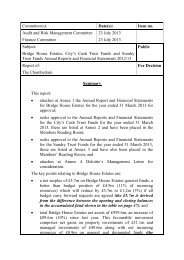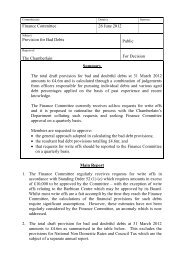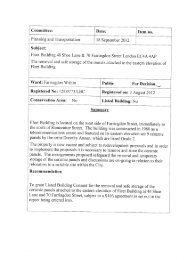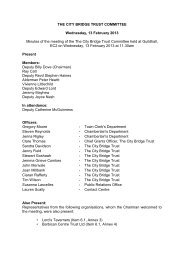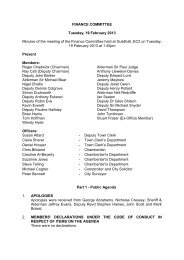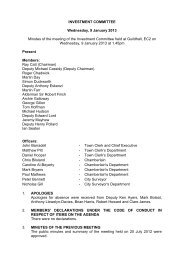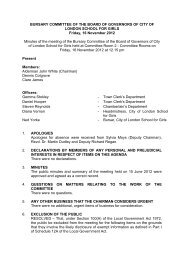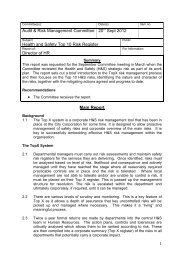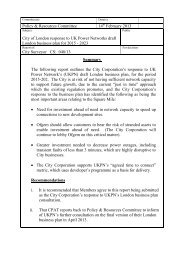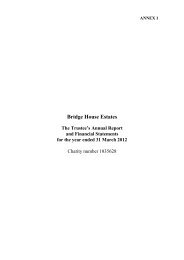The current purpose and management of the Epping Forest Deer ...
The current purpose and management of the Epping Forest Deer ...
The current purpose and management of the Epping Forest Deer ...
Create successful ePaper yourself
Turn your PDF publications into a flip-book with our unique Google optimized e-Paper software.
6. By 1954, a significant decline in <strong>the</strong> <strong>Epping</strong> deer population to 67 animals<br />
had prompted your Committee to consider a series <strong>of</strong> contingency plans<br />
including <strong>the</strong> creation by gift <strong>of</strong> a second melanistic deer herd at<br />
Whipsnade in 1956 <strong>and</strong> <strong>the</strong> purchase in 1959 <strong>of</strong> 35 hectares (88 acres) <strong>of</strong><br />
l<strong>and</strong> at <strong>The</strong>ydon Bois to form a dedicated deer sanctuary. A fur<strong>the</strong>r 9<br />
hectares (24 acres) <strong>of</strong> woodl<strong>and</strong>, would eventually be combined with <strong>the</strong><br />
deer sanctuary in 1980. See appendix 2.<br />
7. At <strong>the</strong> same time <strong>the</strong>re was a wider discussion in post-war Britain regarding<br />
<strong>the</strong> growth <strong>of</strong> <strong>the</strong> „Leisure Society‟ <strong>and</strong> <strong>the</strong> new pressures this would bring<br />
to <strong>the</strong> Countryside, Michael Dower writing in „<strong>The</strong> Fourth Wave‟ (1965)<br />
warned <strong>of</strong> a „wave‟ <strong>of</strong> leisure following industrialisation; railways <strong>and</strong> carbased<br />
suburbs driven by a „battalion <strong>of</strong> cars‟. Such dystopian prophecies<br />
undoubtedly reinforced <strong>the</strong> importance <strong>of</strong> a deer sanctuary away from <strong>the</strong><br />
<strong>Forest</strong>‟s obligations to <strong>the</strong> new age <strong>of</strong> leisure.<br />
8. What is less well understood is whe<strong>the</strong>r <strong>the</strong> concerns <strong>of</strong> <strong>the</strong> time related to<br />
<strong>the</strong> entire loss <strong>of</strong> deer from <strong>the</strong> <strong>Forest</strong> or fundamentally <strong>the</strong> loss <strong>of</strong> <strong>the</strong><br />
melanistic bloodline particularly associated with <strong>Epping</strong> <strong>Forest</strong>.<br />
9. A significant component <strong>of</strong> <strong>the</strong> <strong>management</strong> <strong>of</strong> <strong>the</strong> deer sanctuary is <strong>the</strong><br />
wide ranging restrictions on public access. <strong>The</strong>se restrictions were created<br />
to protect <strong>the</strong> deer from <strong>the</strong> concerns <strong>of</strong> <strong>the</strong> time <strong>and</strong> <strong>the</strong> necessity to<br />
purchase l<strong>and</strong> that could be operated outside <strong>the</strong> <strong>Epping</strong> <strong>Forest</strong> Acts 1878<br />
<strong>and</strong> 1880. In placing <strong>the</strong> deer sanctuary outside <strong>the</strong> stated <strong>purpose</strong>s <strong>of</strong> <strong>the</strong><br />
Acts, <strong>the</strong> continued operation <strong>of</strong> <strong>the</strong> <strong>current</strong> arrangements will create<br />
challenges for <strong>the</strong> Conservators with regard to its legal status.<br />
Current Position<br />
10. <strong>The</strong> <strong>management</strong> <strong>of</strong> <strong>the</strong> sanctuary requires a significant level <strong>of</strong> staff<br />
resources to be made available. An annual cull is set in order to maintain<br />
herd size, sex ratio <strong>and</strong> to control any deer born with alternative colouring<br />
to <strong>the</strong> preferred black (melanistic) colour type. <strong>The</strong> annual cull for a herd <strong>of</strong><br />
100 needs to be in <strong>the</strong> order <strong>of</strong> 40 animals (Langbein 1996), <strong>and</strong> as stated in<br />
<strong>the</strong> 9 July 2012 report to your Committee (<strong>Deer</strong> Management on <strong>the</strong> Buffer<br />
l<strong>and</strong>s) each deer culled requires 0.5 staff days.<br />
11. Welfare checks on <strong>the</strong> herd are to be carried out at least every o<strong>the</strong>r day <strong>and</strong><br />
periodic checks on <strong>the</strong> integrity <strong>of</strong> <strong>the</strong> perimeter fence are essential. Staff<br />
are also required to carry out supplementary feeding <strong>of</strong> <strong>the</strong> deer, from<br />
September through until <strong>the</strong> end <strong>of</strong> March, depending on <strong>the</strong> wea<strong>the</strong>r<br />
conditions, usually being three times a week. <strong>The</strong>re is also a requirement<br />
for some grassl<strong>and</strong> <strong>management</strong> to take place in <strong>the</strong> form <strong>of</strong> grass topping,<br />
harrowing <strong>and</strong> rolling, this can be carried out by in house staff if resources<br />
allow o<strong>the</strong>rwise contractors need to be engaged to carry out <strong>the</strong> works.



